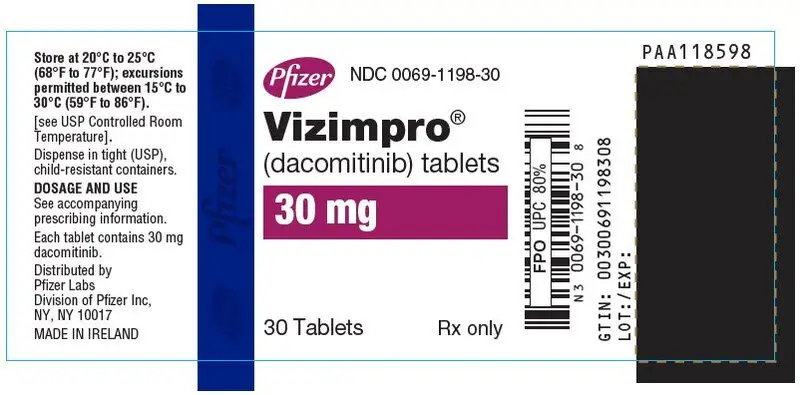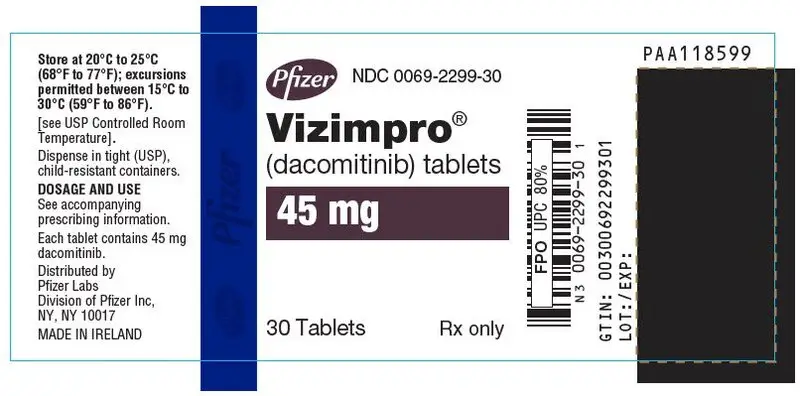Drug Detail:Vizimpro (Dacomitinib [ dak-oh-mi-ti-nib ])
Drug Class: EGFR inhibitors HER2 inhibitors
Highlights of Prescribing Information
VIZIMPRO® (dacomitinib) tablets, for oral use
Initial U.S. Approval: 2018
Indications and Usage for Vizimpro
VIZIMPRO is a kinase inhibitor indicated for the first-line treatment of patients with metastatic non-small cell lung cancer (NSCLC) with epidermal growth factor receptor (EGFR) exon 19 deletion or exon 21 L858R substitution mutations as detected by an FDA-approved test. (1)
Vizimpro Dosage and Administration
Recommended Dosage: 45 mg orally once daily with or without food. (2.2)
Dosage Forms and Strengths
Tablets: 15 mg, 30 mg, and 45 mg. (3)
Contraindications
None. (4)
Warnings and Precautions
- Interstitial Lung Disease (ILD): Permanently discontinue VIZIMPRO if ILD is confirmed. (5.1)
- Diarrhea: Withhold and reduce the dose of VIZIMPRO based on the severity. (2.3, 5.2)
- Dermatologic Adverse Reactions: Withhold and reduce the dose of VIZIMPRO based on the severity. (2.3, 5.3)
- Embryo-Fetal Toxicity: VIZIMPRO can cause fetal harm. Advise females of reproductive potential to use effective contraception. (5.4, 8.1, 8.3)
Adverse Reactions/Side Effects
Most common adverse reactions (incidence >20%) are diarrhea, rash, paronychia, stomatitis, decreased appetite, dry skin, decreased weight, alopecia, cough, and pruritus. (6.1)
To report SUSPECTED ADVERSE REACTIONS, contact Pfizer Inc. at 1-800-438-1985 or FDA at 1-800-FDA-1088 or www.fda.gov/medwatch.
Drug Interactions
- Proton Pump Inhibitors (PPIs): Avoid use with VIZIMPRO; use locally-acting antacids or H2-receptor antagonist; administer VIZIMPRO at least 6 hours before or 10 hours after H2-receptor antagonist. (2.4, 7.1)
- CYP2D6 Substrates: Avoid concomitant use with VIZIMPRO where minimal increases in concentration of the CYP2D6 substrate may lead to serious or life-threatening toxicities. (7.2)
Use In Specific Populations
- Lactation: Advise not to breastfeed. (8.2)
See 17 for PATIENT COUNSELING INFORMATION and FDA-approved patient labeling.
Revised: 12/2020
Full Prescribing Information
1. Indications and Usage for Vizimpro
VIZIMPRO is indicated for the first-line treatment of patients with metastatic non-small cell lung cancer (NSCLC) with epidermal growth factor receptor (EGFR) exon 19 deletion or exon 21 L858R substitution mutations as detected by an FDA-approved test [see Dosage and Administration (2.1)].
2. Vizimpro Dosage and Administration
2.1 Patient Selection
Select patients for the first-line treatment of metastatic NSCLC with VIZIMPRO based on the presence of an EGFR exon 19 deletion or exon 21 L858R substitution mutation in tumor specimens. Information on FDA-approved tests for the detection of EGFR mutations in NSCLC is available at: http://www.fda.gov/CompanionDiagnostics.
2.2 Recommended Dosage
The recommended dosage of VIZIMPRO is 45 mg taken orally once daily, until disease progression or unacceptable toxicity occurs. VIZIMPRO can be taken with or without food [see Dosage and Administration (2.4) and Clinical Pharmacology (12.3)].
Take VIZIMPRO the same time each day. If the patient vomits or misses a dose, do not take an additional dose or make up a missed dose but continue with the next scheduled dose.
2.3 Dosage Modifications for Adverse Reactions
Reduce the dose of VIZIMPRO for adverse reactions as described in Table 1. Dosage modifications for specific adverse reactions are provided in Table 2.
| Dose Level | Dose (Once Daily) |
|---|---|
| First dose reduction | 30 mg |
| Second dose reduction | 15 mg |
| Adverse Reaction | Severity* | Dosage Modification |
|---|---|---|
|
||
| Interstitial lung disease (ILD) [see Warnings and Precautions (5.1)] | Any Grade |
|
| Diarrhea [see Warnings and Precautions (5.2)] | Grade 2 |
|
| Grade 3 or 4 |
|
|
| Dermatologic Adverse Reactions [see Warnings and Precautions (5.3)] | Grade 2 |
|
| Grade 3 or 4 |
|
|
| Other | Grade 3 or 4 |
|
2.4 Dosage Modifications for Acid-Reducing Agents
Avoid the concomitant use of proton pump inhibitors (PPIs) while taking VIZIMPRO. As an alternative to PPIs, use locally-acting antacids or if using an histamine 2 (H2)-receptor antagonist, administer VIZIMPRO at least 6 hours before or 10 hours after taking an H2-receptor antagonist [see Drug Interactions (7.1) and Clinical Pharmacology (12.3)].
3. Dosage Forms and Strengths
Tablets:
- 45 mg: blue film-coated, immediate release, round biconvex tablet, debossed with "Pfizer" on one side and "DCB45" on the other side.
- 30 mg: blue film-coated, immediate release, round biconvex tablet, debossed with "Pfizer" on one side and "DCB30" on the other side.
- 15 mg: blue film-coated, immediate release, round biconvex tablet, debossed with "Pfizer" on one side and "DCB15" on the other side.
5. Warnings and Precautions
5.1 Interstitial Lung Disease (ILD)
Severe and fatal ILD/pneumonitis occurred in patients treated with VIZIMPRO and occurred in 0.5% of the 394 VIZIMPRO-treated patients; 0.3% of cases were fatal.
Monitor patients for pulmonary symptoms indicative of ILD/pneumonitis. Withhold VIZIMPRO and promptly investigate for ILD in patients who present with worsening of respiratory symptoms which may be indicative of ILD (e.g., dyspnea, cough, and fever). Permanently discontinue VIZIMPRO if ILD is confirmed [see Adverse Reactions (6.1)].
5.2 Diarrhea
Severe and fatal diarrhea occurred in patients treated with VIZIMPRO. Diarrhea occurred in 86% of the 394 VIZIMPRO-treated patients; Grade 3 or 4 diarrhea was reported in 11% of patients and 0.3% of cases were fatal.
Withhold VIZIMPRO for Grade 2 or greater diarrhea until recovery to less than or equal to Grade 1 severity, then resume VIZIMPRO at the same or a reduced dose depending on the severity of diarrhea [see Dosage and Administration (2.3) and Adverse Reactions (6.1)]. Promptly initiate anti-diarrheal treatment (loperamide or diphenoxylate hydrochloride with atropine sulfate) for diarrhea.
5.3 Dermatologic Adverse Reactions
Rash and exfoliative skin reactions occurred in patients treated with VIZIMPRO. Rash occurred in 78% of the 394 VIZIMPRO-treated patients; Grade 3 or 4 rash was reported in 21% of patients. Exfoliative skin reactions of any severity were reported in 7% of patients. Grade 3 or 4 exfoliative skin reactions were reported in 1.8% of patients.
Withhold VIZIMPRO for persistent Grade 2 or any Grade 3 or 4 dermatologic adverse reaction until recovery to less than or equal to Grade 1 severity, then resume VIZIMPRO at the same or a reduced dose depending on the severity of the dermatologic adverse reaction [see Dosage and Administration (2.3) and Adverse Reactions (6.1)]. The incidence and severity of rash and exfoliative skin reactions may increase with sun exposure. At the time of initiation of VIZIMPRO, initiate use of moisturizers and appropriate measures to limit sun exposure. Upon development of Grade 1 rash, initiate treatment with topical antibiotics and topical steroids. Initiate oral antibiotics for Grade 2 or more severe dermatologic adverse reactions.
5.4 Embryo-Fetal Toxicity
Based on findings from animal studies and its mechanism of action, VIZIMPRO can cause fetal harm when administered to a pregnant woman. In animal reproduction studies, oral administration of dacomitinib to pregnant rats during the period of organogenesis resulted in an increased incidence of post-implantation loss and reduced fetal body weight at doses resulting in exposures near the exposure at the 45 mg human dose. The absence of EGFR signaling has been shown to result in embryolethality as well as post-natal death in animals. Advise pregnant women of the potential risk to the fetus. Advise females of reproductive potential to use effective contraception during treatment with VIZIMPRO and for at least 17 days after the final dose [see Use in Specific Populations (8.1 and 8.3)].
6. Adverse Reactions/Side Effects
The following adverse drug reactions are described elsewhere in the labeling:
- Interstitial Lung Disease [see Warnings and Precautions (5.1)]
- Diarrhea [see Warnings and Precautions (5.2)]
- Dermatologic Adverse Reactions [see Warnings and Precautions (5.3)]
6.1 Clinical Trials Experience
Because clinical trials are conducted under widely varying conditions, adverse reaction rates observed in the clinical trials of a drug cannot be directly compared to rates in the clinical trials of another drug and may not reflect the rates observed in practice.
The data in the Warnings and Precautions section reflect exposure to VIZIMPRO in 394 patients with first-line or previously treated NSCLC with EGFR exon 19 deletion or exon 21 L858R substitution mutations who received VIZIMPRO at the recommended dose of 45 mg once daily in 4 randomized, active-controlled trials [ARCHER 1050 (N=227), Study A7471009 (N=38), Study A7471011 (N=83), and Study A7471028 (N=16)] and one single-arm trial [Study A7471017 (N=30)]. The median duration of exposure to VIZIMPRO was 10.8 months (range 0.07–68) [see Warnings and Precautions (5)].
The data described below reflect exposure to VIZIMPRO in 227 patients with EGFR mutation-positive, metastatic NSCLC enrolled in a randomized, active-controlled trial (ARCHER 1050); 224 patients received gefitinib 250 mg orally once daily in the active control arm [see Clinical Studies (14)]. Patients were excluded if they had a history of ILD, interstitial pneumonitis, or brain metastases. The median duration of exposure to VIZIMPRO was 15 months (range 0.07–37).
The most common (>20%) adverse reactions in patients treated with VIZIMPRO were diarrhea (87%), rash (69%), paronychia (64%), stomatitis (45%), decreased appetite (31%), dry skin (30%), decreased weight (26%), alopecia (23%), cough (21%), and pruritus (21%).
Serious adverse reactions occurred in 27% of patients treated with VIZIMPRO. The most common (≥1%) serious adverse reactions were diarrhea (2.2%) and interstitial lung disease (1.3%). Dose interruptions occurred in 57% of patients treated with VIZIMPRO. The most frequent (>5%) adverse reactions leading to dose interruptions were rash (23%), paronychia (13%), and diarrhea (10%). Dose reductions occurred in 66% of patients treated with VIZIMPRO. The most frequent (>5%) adverse reactions leading to dose reductions were rash (29%), paronychia (17%), and diarrhea (8%).
Adverse reactions leading to permanent discontinuation of VIZIMPRO occurred in 18% of patients. The most common (>0.5%) adverse reactions leading to permanent discontinuation of VIZIMPRO were: rash (2.6%), interstitial lung disease (1.8%), stomatitis (0.9%), and diarrhea (0.9%).
Tables 3 and 4 summarize the most common adverse reactions and laboratory abnormalities, respectively, in ARCHER 1050. ARCHER 1050 was not designed to demonstrate a statistically significant difference in adverse reaction rates for VIZIMPRO or for gefitinib for any adverse reaction or laboratory value listed in Table 3 or 4.
| Adverse Reaction | VIZIMPRO (N=227) | Gefitinib (N=224) |
||
|---|---|---|---|---|
| All Grades†
% | Grades 3 and 4 % | All Grades % | Grades 3 and 4 % |
|
|
||||
| Gastrointestinal | ||||
| Diarrhea‡ | 87 | 8 | 56 | 0.9 |
| Stomatitis§ | 45 | 4.4 | 19 | 0.4 |
| Nausea | 19 | 1.3 | 22 | 0.4 |
| Constipation | 13 | 0 | 14 | 0 |
| Mouth ulceration | 12 | 0 | 6 | 0 |
| Skin and Subcutaneous Tissue | ||||
| Rash¶ | 69 | 23 | 47 | 0.4 |
| Paronychia# | 64 | 8 | 21 | 1.3 |
| Dry skinÞ | 30 | 1.8 | 19 | 0.4 |
| Alopecia | 23 | 0.4 | 13 | 0 |
| Pruritusß | 21 | 0.9 | 15 | 1.3 |
| Palmar-plantar erythrodysesthesia syndrome | 15 | 0.9 | 3.1 | 0 |
| Dermatitis | 11 | 1.8 | 4 | 0.4 |
| Metabolism and Nutrition | ||||
| Decreased appetite | 31 | 3.1 | 25 | 0.4 |
| Decreased weight | 26 | 2.2 | 17 | 0.4 |
| Respiratory | ||||
| Cough | 21 | 0 | 19 | 0.4 |
| Nasal mucosal disorderà | 19 | 0 | 4.9 | 0 |
| Dyspnea | 13 | 2.2 | 13 | 1.8 |
| Upper respiratory tract infection | 12 | 1.3 | 13 | 0 |
| Chest pain | 10 | 0 | 14 | 0 |
| Eye | ||||
| Conjunctivitis | 19 | 0 | 4 | 0 |
| Musculoskeletal | ||||
| Pain in extremity | 14 | 0 | 12 | 0 |
| Musculoskeletal pain | 12 | 0.9 | 13 | 0 |
| General | ||||
| Asthenia | 13 | 2.2 | 13 | 1.3 |
| Psychiatric | ||||
| Insomnia | 11 | 0.4 | 15 | 0 |
Additional adverse reactions (All Grades) that were reported in <10% of patients who received VIZIMPRO in ARCHER 1050 include:
General: fatigue 9%
Skin and subcutaneous tissue: skin fissures 9%, hypertrichosis 1.3%, skin exfoliation/exfoliative skin reactions 3.5%
Gastrointestinal: vomiting 9%
Nervous system: dysgeusia 7%
Respiratory: interstitial lung disease 2.6%
Ocular: keratitis 1.8%
Metabolism and nutrition: dehydration 1.3%
| Laboratory Test Abnormality† | VIZIMPRO | Gefitinib | ||
|---|---|---|---|---|
| Change from Baseline All Grades (%) | Change from Baseline to Grade 3 or Grade 4 (%) | Change from Baseline All Grades (%) | Change from Baseline to Grade 3 or Grade 4 (%) |
|
| ALT=alanine aminotransferase; AST=aspartate aminotransferase. | ||||
|
||||
| Hematology | ||||
| Anemia | 44 | 0.9 | 26 | 2.7 |
| Lymphopenia | 42 | 6 | 35 | 2.7 |
| Chemistry | ||||
| Hypoalbuminemia | 44 | 0 | 34 | 0 |
| Increased ALT | 40 | 1.4 | 63 | 13 |
| Hyperglycemia | 36 | 1.0 | 38 | 2.5 |
| Increased AST | 35 | 0.5 | 57 | 8 |
| Hypocalcemia | 33 | 1.4 | 28 | 2.0 |
| Hypokalemia | 29 | 7 | 18 | 2.0 |
| Hyponatremia | 26 | 2.9 | 20 | 1.5 |
| Increased creatinine | 24 | 0 | 16 | 0.5 |
| Increased alkaline phosphatase | 22 | 0.5 | 21 | 2.0 |
| Hypomagnesemia | 22 | 0.5 | 9 | 0 |
| Hyperbilirubinemia | 16 | 0.5 | 22 | 0.5 |
7. Drug Interactions
7.1 Effect of Other Drugs on VIZIMPRO
Concomitant use with a PPI decreases dacomitinib concentrations, which may reduce VIZIMPRO efficacy. Avoid the concomitant use of PPIs with VIZIMPRO. As an alternative to PPIs, use locally-acting antacids or an H2-receptor antagonist. Administer VIZIMPRO at least 6 hours before or 10 hours after taking an H2-receptor antagonist [see Dosage and Administration (2.4) and Clinical Pharmacology (12.3)].
7.2 Effect of VIZIMPRO on CYP2D6 Substrates
Concomitant use of VIZIMPRO increases the concentration of drugs that are CYP2D6 substrates [see Clinical Pharmacology (12.3)] which may increase the risk of toxicities of these drugs. Avoid concomitant use of VIZIMPRO with CYP2D6 substrates where minimal increases in concentration of the CYP2D6 substrate may lead to serious or life-threatening toxicities.
8. Use In Specific Populations
8.5 Geriatric Use
Of the total number of patients (N=394) in five clinical studies with EGFR mutation-positive NSCLC who received VIZIMPRO at a dose of 45 mg orally once daily [ARCHER 1050 (N=227), Study A7471009 (N=38), Study A7471011 (N=83), Study A7471028 (N=16), and Study A7471017 (N=30)] 40% were 65 years of age and older.
Exploratory analyses across this population suggest a higher incidence of Grade 3 and 4 adverse reactions (67% versus 56%, respectively), more frequent dose interruptions (53% versus 45%, respectively), and more frequent discontinuations (24% versus 10%, respectively) for adverse reactions in patients 65 years or older as compared to those younger than 65 years.
8.6 Renal Impairment
No dosage modification is recommended for patients with mild or moderate renal impairment (creatinine clearance [CLcr] 30 to 89 mL/min estimated by Cockcroft-Gault). The recommended dose of VIZIMPRO has not been established for patients with severe renal impairment (CLcr <30 mL/min) [see Clinical Pharmacology (12.3)].
11. Vizimpro Description
Dacomitinib is an oral kinase inhibitor with a molecular formula of C24H25ClFN5O2 ∙ H2O and a molecular weight of 487.95 Daltons. The chemical name is: (2E)-N-{4-[(3-Chloro-4-fluorophenyl)amino]-7-methoxyquinazolin-6-yl}-4-(piperidin-1-yl)but-2-enamide monohydrate and its structural formula is:
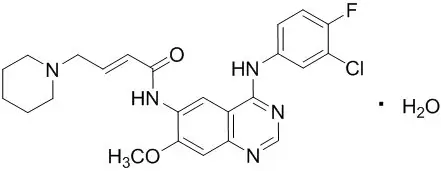
Dacomitinib is a white to pale yellow powder.
VIZIMPRO tablets contain 45, 30, or 15 mg of dacomitinib with the following inactive ingredients in the tablet core; lactose monohydrate, microcrystalline cellulose, sodium starch glycolate, and magnesium stearate. The film coating consists of Opadry II® Blue 85F30716 containing: Polyvinyl alcohol – partially hydrolyzed, Talc, Titanium dioxide, Macrogol/PEG 3350, and FD&C Blue #2/Indigo Carmine Aluminum Lake.
12. Vizimpro - Clinical Pharmacology
12.1 Mechanism of Action
Dacomitinib is an irreversible inhibitor of the kinase activity of the human EGFR family (EGFR/HER1, HER2, and HER4) and certain EGFR activating mutations (exon 19 deletion or the exon 21 L858R substitution mutation). In vitro dacomitinib also inhibited the activity of DDR1, EPHA6, LCK, DDR2, and MNK1 at clinically relevant concentrations.
Dacomitinib demonstrated dose-dependent inhibition of EGFR and HER2 autophosphorylation and tumor growth in mice bearing subcutaneously implanted human tumor xenografts driven by HER family targets including mutated EGFR. Dacomitinib also exhibited antitumor activity in orally-dosed mice bearing intracranial human tumor xenografts driven by EGFR amplifications.
12.3 Pharmacokinetics
The maximum dacomitinib plasma concentration (Cmax) and AUC at steady state increased proportionally over the dose range of VIZIMPRO 2 mg to 60 mg orally once daily (0.04 to 1.3 times the recommended dose) across dacomitinib studies in patients with cancer. At a dose of 45 mg orally once daily, the geometric mean [coefficient of variation (CV%)] Cmax was 108 ng/mL (35%) and the AUC0–24h was 2213 ng∙h/mL (35%) at steady state in a dose-finding clinical study conducted in patients with solid tumors. Steady state was achieved within 14 days following repeated dosing and the estimated geometric mean (CV%) accumulation ratio was 5.7 (28%) based on AUC.
13. Nonclinical Toxicology
13.1 Carcinogenesis, Mutagenesis, Impairment of Fertility
Carcinogenicity studies have not been performed with VIZIMPRO.
Dacomitinib was not mutagenic in a bacterial reverse mutation (Ames) assay or clastogenic in an in vitro human lymphocyte chromosome aberration assay or clastogenic or aneugenic in an in vivo rat bone marrow micronucleus assay.
Daily oral administration of dacomitinib at doses ≥ 0.5 mg/kg/day to female rats (approximately 0.14 times the exposure based on AUC at the 45 mg human dose) resulted in reversible epithelial atrophy in the cervix and vagina. Oral administration of dacomitinib at 2 mg/kg/day to male rats (approximately 0.6 times the human exposure based on AUC at the 45 mg clinical dose) resulted in reversible decreased secretion in the prostate gland.
14. Clinical Studies
The efficacy of VIZIMPRO was demonstrated in a randomized, multicenter, multinational, open-label study (ARCHER 1050; [NCT01774721]). Patients were required to have unresectable, metastatic NSCLC with no prior therapy for metastatic disease or recurrent disease with a minimum of 12 months disease-free after completion of systemic therapy; an Eastern Cooperative Oncology Group (ECOG) performance status of 0 or 1; EGFR exon 19 deletion or exon 21 L858R substitution mutations. EGFR mutation status was prospectively determined by local laboratory or commercially available tests (e.g., therascreen® EGFR RGQ PCR and cobas® EGFR Mutation Test).
Patients were randomized (1:1) to receive VIZIMPRO 45 mg orally once daily or gefitinib 250 mg orally once daily until disease progression or unacceptable toxicity. Randomization was stratified by region (Japanese versus mainland Chinese versus other East Asian versus non-East Asian), and EGFR mutation status (exon 19 deletions versus exon 21 L858R substitution mutation). The major efficacy outcome measure was progression-free survival (PFS) as determined by blinded Independent Radiologic Central (IRC) review per RECIST v1.1. Additional efficacy outcome measures were overall response rate (ORR), duration of response (DoR), and overall survival (OS).
A total of 452 patients were randomized to receive VIZIMPRO (N=227) or gefitinib (N=225). The demographic characteristics were 60% female; median age 62 years (range: 28 to 87), with 40% aged 65 years and older; and 23% White, 77% Asian, and less than 1% Black. Prognostic and tumor characteristics were ECOG performance status 0 (30%) or 1 (70%); 59% with exon 19 deletion and 41% with exon 21 L858R substitution; Stage IIIB (8%) and Stage IV (92%); 64% were never smokers; and 1% received prior adjuvant or neoadjuvant therapy.
ARCHER 1050 demonstrated a statistically significant improvement in PFS as determined by the IRC. Results are summarized in Table 5 and Figures 1 and 2.
The hierarchical statistical testing order was PFS followed by ORR and then OS. No formal testing of OS was conducted since the formal comparison of ORR was not statistically significant.
| VIZIMPRO N=227 | Gefitinib N=225 |
|
|---|---|---|
| CI=confidence interval; DoR=duration of response; HR=hazard ratio; IRC=Independent Radiologic Central; N/n=total number; PFS=progression-free survival. | ||
|
||
| Progression-Free Survival (per IRC) | ||
| Number of patients with event, n (%) | 136 (59.9%) | 179 (79.6%) |
| Median PFS in months (95% CI) | 14.7 (11.1, 16.6) | 9.2 (9.1, 11.0) |
| HR (95% CI)* | 0.59 (0.47, 0.74) | |
| p-value† | <0.0001 | |
| Overall Response Rate (per IRC) | ||
| Overall Response Rate % (95% CI) | 75% (69, 80) | 72% (65, 77) |
| p-value‡ | 0.39 | |
| Duration of Response in Responders (per IRC) | ||
| Median DoR in months (95% CI) | 14.8 (12.0, 17.4) | 8.3 (7.4, 9.2) |
Figure 1. Kaplan-Meier Curve for PFS per IRC Review in ARCHER 1050
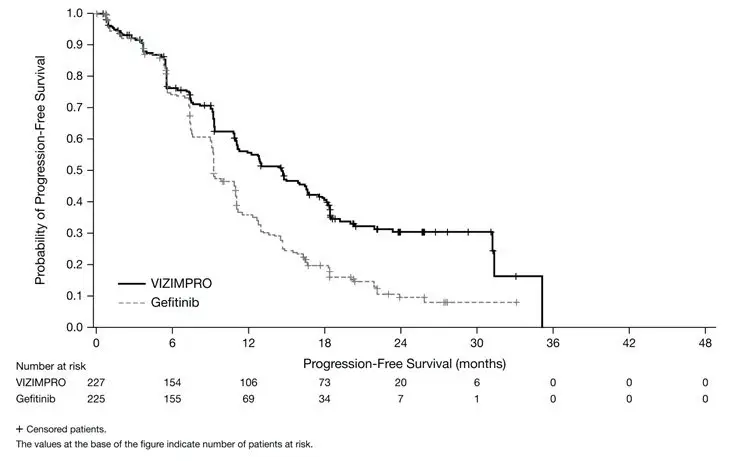
Figure 2. Kaplan-Meier Curve for OS in ARCHER 1050
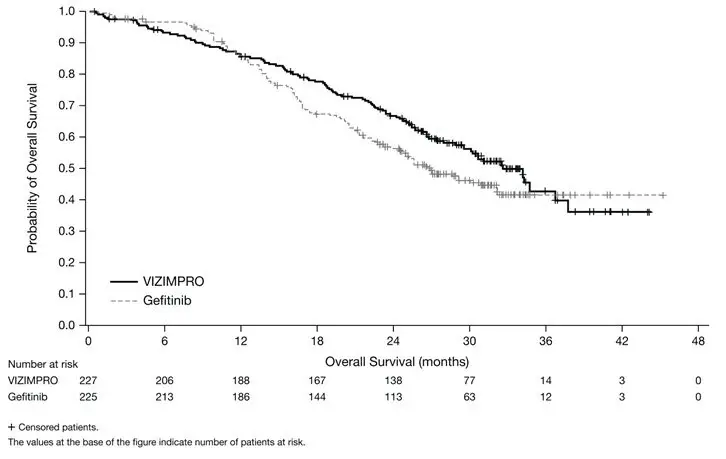
16. How is Vizimpro supplied
VIZIMPRO is supplied in strengths and package configurations as described in Table 6 below:
| VIZIMPRO Tablets | |||
|---|---|---|---|
| Package Configuration | Tablet Strength (mg) | NDC | Tablet Description |
| 30-Count Bottle with a child-resistant closure | 15 | 0069-0197-30 | Blue film-coated, immediate release, round biconvex tablet, debossed with "Pfizer" on one side and "DCB15" on the other side. |
| 30-Count Bottle with a child-resistant closure | 30 | 0069-1198-30 | Blue film-coated immediate release, round biconvex tablet, debossed with "Pfizer" on one side and "DCB30" on the other side. |
| 30-Count Bottle with a child-resistant closure | 45 | 0069-2299-30 | Blue film-coated immediate release, round biconvex tablet, debossed with "Pfizer" on one side and "DCB45" on the other side. |
17. Patient Counseling Information
Advise the patient to read the FDA-approved patient labeling (Patient Information).
| This Patient Information has been approved by the U.S. Food and Drug Administration. | Issued: September 2018 | |
| PATIENT INFORMATION VIZIMPRO® (vih-ZIM-pro) (dacomitinib) tablets |
||
| What is VIZIMPRO?
VIZIMPRO is a prescription medicine used to treat non-small cell lung cancer (NSCLC) that has spread to other parts of the body (metastatic):
It is not known if VIZIMPRO is safe and effective in children. |
||
Before taking VIZIMPRO, tell your healthcare provider about all your medical conditions, including if you:
|
||
How should I take VIZIMPRO?
|
||
What should I avoid during treatment with VIZIMPRO?
|
||
| What are the possible side effects of VIZIMPRO? VIZIMPRO may cause serious side effects, including:
|
||
|
|
|
| Call your doctor for medical advice about side effects. You may report side effects to FDA at 1-800-FDA-1088. | ||
How should I store VIZIMPRO?
|
||
| General information about the safe and effective use of VIZIMPRO.
Medicines are sometimes prescribed for purposes other than those listed in a Patient Information leaflet. Do not use VIZIMPRO for a condition for which it was not prescribed. Do not give VIZIMPRO to other people, even if they have the same symptoms you have. It may harm them. You can ask your pharmacist or healthcare provider for more information about VIZIMPRO that is written for health professionals. |
||
| What are the ingredients in VIZIMPRO? Active ingredient: dacomitinib Inactive ingredients: lactose monohydrate, microcrystalline cellulose, sodium starch glycolate, and magnesium stearate. Film coating contains: Opadry II® Blue 85F30716 containing: Polyvinyl alcohol – partially hydrolyzed, Talc, Titanium dioxide, Macrogol/PEG 3350, and FD&C Blue #2/Indigo Carmine Aluminum Lake.
For more information, go to www.VIZIMPRO.com or call 1-800-438-1985. |
||
| VIZIMPRO
dacomitinib tablet, film coated |
||||||||||||||||||||||
|
||||||||||||||||||||||
|
||||||||||||||||||||||
|
||||||||||||||||||||||
|
||||||||||||||||||||||
|
||||||||||||||||||||||
|
||||||||||||||||||||||
| VIZIMPRO
dacomitinib tablet, film coated |
||||||||||||||||||||||
|
||||||||||||||||||||||
|
||||||||||||||||||||||
|
||||||||||||||||||||||
|
||||||||||||||||||||||
|
||||||||||||||||||||||
|
||||||||||||||||||||||
| VIZIMPRO
dacomitinib tablet, film coated |
||||||||||||||||||||||
|
||||||||||||||||||||||
|
||||||||||||||||||||||
|
||||||||||||||||||||||
|
||||||||||||||||||||||
|
||||||||||||||||||||||
|
||||||||||||||||||||||
| Labeler - Pfizer Laboratories Div Pfizer Inc (134489525) |
| Establishment | |||
| Name | Address | ID/FEI | Business Operations |
|---|---|---|---|
| Pfizer Pharmaceuticals LLC | 829084552 | ANALYSIS(0069-0197, 0069-1198, 0069-2299) , PACK(0069-0197, 0069-1198, 0069-2299) , LABEL(0069-0197, 0069-1198, 0069-2299) | |
| Establishment | |||
| Name | Address | ID/FEI | Business Operations |
|---|---|---|---|
| Pharmacia & Upjohn Company LLC | 618054084 | ANALYSIS(0069-0197, 0069-1198, 0069-2299) , PACK(0069-0197, 0069-1198, 0069-2299) , LABEL(0069-0197, 0069-1198, 0069-2299) | |
| Establishment | |||
| Name | Address | ID/FEI | Business Operations |
|---|---|---|---|
| Pfizer Ireland Pharmaceuticals | 985052076 | ANALYSIS(0069-0197, 0069-1198, 0069-2299) , API MANUFACTURE(0069-0197, 0069-1198, 0069-2299) | |
| Establishment | |||
| Name | Address | ID/FEI | Business Operations |
|---|---|---|---|
| Pfizer Manufacturing Deutschland GmbH | 341970073 | ANALYSIS(0069-0197, 0069-1198, 0069-2299) , MANUFACTURE(0069-0197, 0069-1198, 0069-2299) , PACK(0069-0197, 0069-1198, 0069-2299) , LABEL(0069-0197, 0069-1198, 0069-2299) | |







